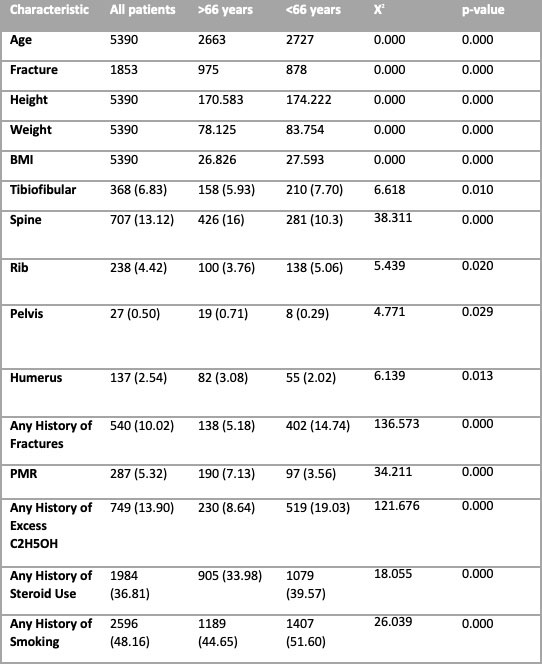Session Information
Date: Sunday, November 13, 2022
Title: Osteoporosis and Metabolic Bone Disease – Basic and Clinical Science Poster
Session Type: Poster Session C
Session Time: 1:00PM-3:00PM
Background/Purpose: Data on osteoporosis in men are scarce. The World Health Organisation’s (WHO) definition of a T-score less than 2.5 has only been described for women. It is therefore important to understand the determinant of poor bone health in males. Males referred for Bone Mineral Density (BMD) estimation are a good source of exploring such poor bone health. We sought to investigate the epidemiology and determinants of reduced bone well-being as well as fragility fractures in a population of males referred for BMD estimation using Dual X-Ray Absorptiometry (DEXA) scans.
Methods: Data were obtained from patients in primary and secondary care referred to a district BMD scanner in the Northwest of England. Males referred between 2004 and 2019 were selected and divided into two groups: above and below the median referral age. Initially comparisons were made using Chi Squared test for categorical variables and T-test for continuous variables.
Results: A total of 5390 male patients were included in this analysis, the median age at scan was 66 years (IQR) and the mean age was 76.6 +/- 13.7 (SD). Significantly greater numbers of tibiofibular 210 (7.70%) and rib 138 (5.06%) fractures were seen in those under the age of 66. Whereas their older counterparts saw greater numbers of spine 426 (16%), femur 166 (6.23%) and pelvis 19 (0.71%) fractures, as depicted by Table 1. The table also shows those under the median age had a more extensive history of smoking, steroid, and alcohol use whilst also, on average, being taller and weighing more. Patients in the older cohort, however, had a greater prevalence of Polymyalgia Rheumatica. A summary of the differences is shown in Table 1.
Conclusion: This study identifies alternate fracture patterns among males of differing ages. Those under the age of 66 years saw higher numbers of tibiofibular and rib fractures compared to those older. Such patients also had a more extensive history of smoking as well as steroid and alcohol use. On the other hand, those older than the median age suffered greater numbers of spine, pelvis and femur fractures whilst also being relatively shorter and weighing less. Further work is required to study predictors of fractures in each group adjusted and unadjusted for age.
To cite this abstract in AMA style:
Khan M, Hamad R, Amin H, Bukhari M. The Epidemiology of Old versus Young Males Referred for BMD Assessment [abstract]. Arthritis Rheumatol. 2022; 74 (suppl 9). https://acrabstracts.org/abstract/the-epidemiology-of-old-versus-young-males-referred-for-bmd-assessment/. Accessed .« Back to ACR Convergence 2022
ACR Meeting Abstracts - https://acrabstracts.org/abstract/the-epidemiology-of-old-versus-young-males-referred-for-bmd-assessment/

